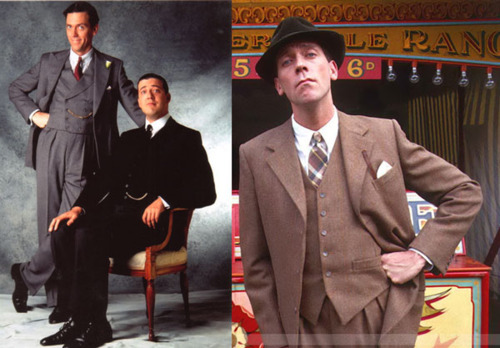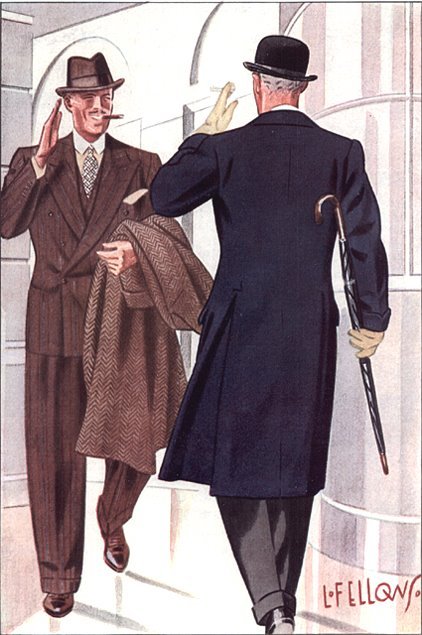
Country Mouse & City Mouse
Almost all of menswear’s tradition is based in England, and particularly the England of the late 19th and early 20th centuries. The lifestyle of the upper and upper-middle classes at the time – professionals and gentry alike – was sharply defined by geography. If you had the money, you lived two lives: one in the city, one in the country. Each of these lives had a wardrobe, and each of these wardrobes was distinctive.
This separation still shapes our dress today. Let’s take a look at how.

You can see this distinction if you watch a period television show. Jeeves & Wooster is a favorite of mine, with two brilliantly hilarious performances from Stephen Fry and Hugh Laurie. As Bertie Wooster, Laurie flits between city and country, discarding his conservative urban attire (left), and donning country togs (right). Sometimes absurdly outrageous ones.

As Downton Abbey has crossed the threshold of World War One and moved toward modernity, the clothes have become more recognizable there, as well. Since almost all the action on the show takes place on a country estate, you’ll see almost exclusively country clothes. You’ll also recognize the role that outdoor sports have played in the development of menswear, and of the distinction between country and city.

But is this antiquated tradition meaningful to us in modern times? Do we owe anything to the gentlemen above, passing each other on the train platform, one headed into town, one out?
Absolutely.
Let’s start simply, though, by defining better what “country” and “city” clothes are.
What Are City Clothes?
Broadly speaking, city clothes are made to match the aesthetics and demands of city life. That means they’re largely built for business.
Defining characteristics:
- An urban color palette of gray and blue.
- Solid-colored suits.
- Business-striped suits.
- Small-scale checks in conservative colors.
- Worsted wool.
- Black leather shoes and accessories.
- Color in patterned shirts and (in some cases) ties.
- Dressing down from suits with conservative blazers.
What are Country Clothes?
Country clothes are defined by their sporting heritage and their ties to the colors of the outdoors.
Defining characteristics:
- A country color palette featuring the colors of nature, like tans, browns, and greens, with sometimes-bold complimentary accents, like burgundy and orange.
- Frequent use of bold patterns, like checks and multi-colored tweeds.
- Suits often replaced with sport coats and odd (non-matching) trousers.
- Sporting details like hacking pockets, ticket pockets, patch pockets and leather buttons.
- Fabrics with soft finishes and sporting heritage, like tweed, corduroy and flannel.
- Brown leather accessories, including suede and heavier shoes and boots.
What does this mean today?
Unless you’re a member of the House of Lords, it’s unlikely that you’ll be flitting between a Mayfair manor and a country house, with a special wardrobe for each and a valet like Jeeves to keep you dressed appropriately for your milieu. Many folks in the first world live between country and city these days, in suburban and exurban environments that are neither dominated by gray concrete nor appropriate for grouse hunting. The days of strict adherence to the line between country and city are over – but understanding the line is still important.
Remember that these lines aren’t just about place, they’re also about tone. City clothes are still the most appropriate for most business contexts. Show up to court in tweed and you’ll still look foolish in the 21st century. Country clothes are still the most relaxed – that’s why you can wear heavy country brogues with jeans but sleek black cap-toes would look out of place.
So consider the tone of the place where you live, and the activities that make up your daily life. If you’re a city lawyer, your wardrobe should be dominated by traditional city clothes. On weekends, you can dabble in country garb. If you live in the outskirts of Savannah, where you’re a graphic artist, you can wear blue jeans and tweed without looking out of place at the Piggly Wiggly. No matter what you choose to wear, let it be informed by a hundred years of history and tradition.